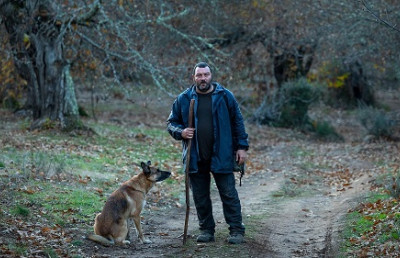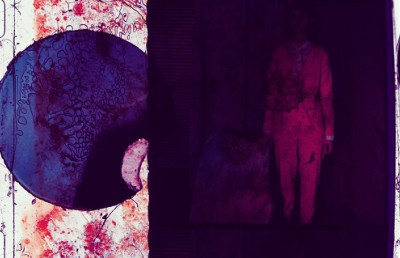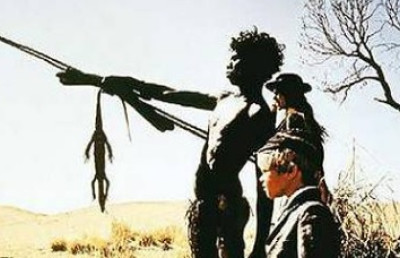Vancouver’s Narrative Architecture
Dispossessing the Marginalized

Circa 1948 (Image source, National Film Board)
While Vancouver has consistently been seen and advertised as an ideal tourist destination that at once combines a city lifestyle close to nature and the wilderness just outside its boundaries, its’ close relation to the film industry in the United States and its coastal geography, its darker histories of displacement and dispossession are conveniently effaced nationally and institutionally. However, this effacement or collective amnesia in Vancouver has a long and continuing history rooted in white-settler colonial racism that marginalizes, unsettles, and erases Indigenous, Black, Asian, and other racialized minorities on the unsettled land we call Canada. Within Canada’s history, as many scholars and Indigenous communities have noted, the forced displacement and erasure of these marginalized populations within what is now the Vancouver area stems early on from the first settler’s uprooting indigenous Squamish and Musqueam peoples to expand its settlement (Barman). Following similar patterns and narratives of expansionism that lead back to the unsettling of Indigenous peoples across time, contemporary post-war Vancouver recapitulates this process.
Through the rapid development and expansion of the city due to the increasing settler population, urban planning, and car culture dominated metropolitan discourse at the beginning of the 1940s and onward. The city had to create or obtain the necessary space for housing, transportation systems, and public infrastructure to meet the demands of a rapidly growing, predominantly white middle-class populace. With the onset of municipal discourse directed towards urban redevelopment, renewal, and renovation, the city set its sights on a few of the poorest, racialized neighbourhoods: Hogan’s Alley and Chinatown.
By tracing the various lived realities, representations, and narratives surrounding urban renewal and development within Vancouver’s history, this paper will look at The City of Vancouver’s short film To Build a Better City (1964) and Stan Douglas’ interactive app Circa 1948 (2015). Beginning with how the city of Vancouver in To Build a Better City portrays poor or underdeveloped neighbourhoods, afflicted with social and economic decay, described as “blight,” Circa 1948 in its virtual re-creation of the now obsolete town of Hogan’s Alley, redresses the prejudice motivating mass displacement due to the city’s expansion. In tandem with the white-settler expansionist narratives that the Canadian state repeatedly enforces throughout its history (such as of Amber Valley, Alberta; Africaville, NS; and similarly Seattle’s Central District (CD) in Washington DC), gestures to the insidious, widespread settler-colonial system that depends upon Indigenous and Black bodies to sustain itself.
The municipally funded short film To Build a Better City features Vancouver’s modern architecture alongside the various people who live and inhabit the city. By situating the city as one that is motivated by innovative industry and increasing population growth, reflected in the “ever-changing skyline,” the film portrays itself in relation to other burgeoning cosmopolitan cities such as Toronto or Seattle. Through this tactic, any lag or setback in progress that hinders the city’s growth is portrayed as unproductive and thus unprofitable in the film’s rhetoric, urban development and renewal are normalized as part of a city’s natural cycle or response to the exceeding demands of expansion and population growth. However, how the dilapidated district is represented puts the responsibility of its decaying condition as the responsibility of the resident—not pointing to those with upward social mobility that own and rent out the property. Though some of these instances may vary from homeownership, rental, or leased spaces from resident to resident, the wasted productivity of the area itself is framed as deteriorating the value of the housing market, which is, in turn, detrimental to the image of the city itself.
As Blomley summarizes:
The ownership model shapes political and ethical discourse on the city. It offers a morally impoverished vocabulary for reflecting on urban affairs. Urban planning, for example, is imagined as a discourse on land use, not land rights. Issues such as gentrification in Vancouver’s Downtown Eastside are consequently framed in particular ways (155).
The joint NFB/CMHC documentary targets the look or aesthetic of poorer neighbourhoods and hones in on the unprofitability and lower social classes that depend upon low-income housing and/or dwellings. In this way, the film positions these poorer districts within the rhetoric of poor living standards and quality of life based on the surrounding upscale living conditions of the mobile upward social classes. Due to the rapid growth rate of the population and the rising demand for (affordable) housing, the film creates, “[…] a very bourgeois binary between the deserving and undeserving poor” (Proudfoot 97). As the film continues, however, it becomes clear that neither the humans nor the communities are consulted based on how the neighbourhood serves their (collective) needs. While the film assures the spectator and perhaps the Vancouver city dweller of providing better housing for the betterment of the communities that are affected by blight, the following redevelopment plans only compound these issues by fracturing and displacing communities in favour of making space productive and profitable. Thus the push towards gentrification and urban renewal is motivated by underlying market values and future profitability that is then open to both municipal and private land acquisition and construction in the area.
The same rhetoric surrounding urban renewal is similarly reflected through the process of gentrification in unsettling marginalized communities. In this sense, gentrification refers to, “[…] a shift in the role of the city to one of capital accumulation rather than social reproduction,” where the, “[…] (i)ncreased cultural value of the neighbourhood, and social capital of residents, results in the displacement and social exclusion of lower and working-class residents.” (158, 159) However, following the acquisition and clearance of land, in the case of urban renewal, places the property or land use at the disposal of the municipal, provincial, and federal governments that target low-income or poor housing districts and compartmentalize whole communities into large-scale housing projects that condense populations into less space. In this way, the combination of government institutions from the municipal to the federal level contributes to and naturalizes the urban renewal process that continually disenfranchises communities.
Following Canada’s, and more specifically, Vancouver’s repeating histories of land acquisition resulting in metropolitan or city development relies on the erasure of communities, rooted in unsettling and restricting, in this case, Indigenous people to reserve land. Barman notes that white settlers, “[…] agreed that Indians who did not use land set aside for them in ways consistent with newcomers’ assumptions had no right to retain it. Urbanization caused reserves in or near cities to be especially coveted” (5). In other words, reserve land became sought after as valuable but unproductive property that the city and private investors saw as a wasted opportunity and posed a hindrance to Vancouver’s growing population and increasing demand for space. Over time, this process came to be naturalized as the onset of car culture and suburban lifestyle changed how the city functioned, thus requiring more space for housing and improved transportation. As such, urban planning discourse was directed towards land use rather than rights (or land claims) that only considered the property’s market value— not how the land or space provides or serves the needs of those communities already settled. By framing urban renewal and renovation as blight removal that targets poor and disenfranchised neighbourhoods, as seen in To Build A Better City, Vancouver repeats this process of displacement within a metropolitan social, industrial complex analyzed in Secret Vancouver: Return to Hogan’s Alley (2016).
The short documentary Secret Vancouver: Return to Hogan’s Alley briefly addresses the consequences of urban renewal and city planning that erased an infamous black neighbourhood called Hogan’s Alley, located in Vancouver’s DownTown EastSide (DTES), from the city’s map and cultural memory. Throughout the short documentary, various generations of people who had lived in the neighbourhood and scholars speak of the cultural significance and impact the diverse neighbourhood had that added to Vancouver’s image as Hollywood North. As a hang-out for Hollywood stars and jazz musicians to visit, Hogan’s Alley, a poor, immigrant, working-class neighbourhood intimately entwined within Chinatown and Japantown, provided illicitly and, at the time, morally compromising goods and services.
Purvey and Belshaw historically characterize and describe Hogan’s Alley as follows:
The city’s largest cluster of Afro-Canadians settled on the western edge of Strathcona, into an almost legendary neighbourhood between Prior and Union Streets. Nicknamed “Hogan’s Alley” – possibly for local musician Harry Hogan who lived at Union and Dunlevy, but just as likely for the contemporary comic strip of the same name, it was a lively block with a reputation for extraordinary music, no-frills food, illegal liquor, a little pandemonium, sexual (mis)adventure, and sometimes violence (52).
By discussing the devastating impact that the creation of the twelve-lane Georgia Viaduct had in specifically fragmenting and displacing the Hogan’s Alley community, the scholars recount how surrounding neighbourhoods, once aware of the unjust displacements that Vancouver’s twenty-year redevelopment plan had in store, protested. Moreover, the active protest against the demolition of communities that would only serve to condense larger populations into smaller spaces for future profitability to accommodate increasing urban populations stopped the remaining redevelopment; however, not before the demolishment of Hogan’s Alley.
Utilizing the hindsight that the short documentary foregrounds in relating the richness of Hogan’s Alleys black community and its history, Stan Douglas’ app Circa 1948 explores the virtual rendering of haunting narratives that confronts displacement and erasure. Situating Circa 1948 within an interactive experience (either on the app, virtual reality (VR), or gallery installations) allows the player to wander through imagined ruins and eavesdrop on the remaining spectres that populate the urban space. In tracing these erased voices and histories, in part related to how the Canadian institution displaces entire communities and dispossesses racialized communities throughout its history, these romanticized narratives centred around urban renewal, Circa 1948, allow the player to inhabit the remains of the haunting neighbourhood. By recreating the erased space of Hogan’s Alley in Vancouver’s DTES, the player can explore the gritty, underground cityscape that enacts historical, diegetic, and present discourse in relation to the Georgia Viaduct that was inevitably built over top of the fractured community.
In Henry Jenkins’s discussion of the roles and discourses of ludology (game mechanics) and narratology (narrative), he debates the critical factors in retaining compelling gameplay and player immersion. By situating both sides of the debate within an argument of narrative architecture, Jenkins expands the stagnant debate of narrative, game mechanics, and gameplay through the layering of spatial or environmental storytelling. By layering the atmospheric sounds of the neighbourhood, Circa 1948 presents a mapping of the neighbourhood and the relations between the communities that gathered there. The sounds of radio broadcasts and record players in the background that speak about “the good life” and the surrounding issues of squatters and the housing crisis provide the contextual and historical underpinnings of what Vancouver represented itself as during this time. By listening or eavesdropping on these circulating issues that appear to arise city-wide, the ghostly residents of Hogan’s Alley directly challenge and resist the standards and narratives that the city has created. In challenging these imaginary narratives that centre around white-settler sexuality and reproduction, the Hogan’s Alley community, through their ghostly present absence, directly confront the city’s expansionist narratives rooted within white-settler colonialism (Clark and Haraway).
Jenkins describes the following or environmental storytelling and narrative architecture:
Environmental storytelling creates the preconditions for an immersive narrative experience in at least one of four ways: spatial stories can evoke pre-existing narrative associations; they can provide a staging ground where narrative events are enacted; they may embed narrative information within their mise-en-scene; or they provide resources for emergent narratives. (Jenkins 122)
By defining the characteristics that embody the environmental storytelling and narrative architecture of game spaces, Jenkins’ argument situates Circa 1948 as a simple point-and-click app where the player follows discoverable (glowing) artifacts within a small section of Hogan’s Alley. These artifacts allow the player to intimately explore and discover the lived reality and history that the neighbourhood residents encountered amidst the city’s expansionist rhetoric. In this way, “[t]he game world becomes a kind of information space, a memory palace,” where the artifacts scattered around the game space prompt narrative through the players’ exploration of the space (Jenkins 126). Through the intertwined micro-narratives that are introduced, narrative information is given about the neighbourhoods that represent the lived reality and threat of displacement and dispossession that is targeted towards racialized communities.
Both the characters May Lou, who runs a prostitution house as well as an illegal import business in Chinatown, and Mary, the backyard beer garden entrepreneur, are prominent characters that contribute to the community as well as the larger Vancouver area. In particular, as the narrative continues, both characters provide more significant critiques of the demolition of the area and the subsequent irreparable cultural and social impacts that would ensue. The threat of May Lou losing valuable business that supports but also exploits the Chinese community, and Mary’s beer garden, which functions as an after-party space for Hollywood celebrities and famous musicians, is what generates industry in Hogan’s Alley and Chinatown. Their proximity to one another in the neighbourhood foregrounds the variety of relationships, businesses, and community issues that shape the game environment and its reflection or impression in the eyes of the city. The radio and corrupt police officers function in that they uphold a specific standard or perspective of Vancouver while simultaneously exploiting the seedier or unsavoury services offered within Hogan’s Alley and Chinatown. Through these relationships within the neighbourhood and their extension beyond the community, the app at once localizes the issues that affect the community while also weaving the narratives into an extensive history—one that critiques the city’s crooked imperatives for expansion disguised as urban development and renewal. Here, the noir aesthetic adds to the gritty adaptation and re_—presentation of Hogan’s Alley in the game space that is used to criticize and undermine corrupt law enforcement, prejudiced government legislation and policy, and the policing and surveillance of marginalized bodies. _Circa 1948, within the small locality of Hogan’s Alley, narrative pathway(s) provide the player with in-depth environmental storytelling of the neighbourhood, revealing more about the community’s vitality than the blight the city planners fixated on.
In collaboration with the National Film Board of Canada (NFB), Stan Douglas described the following of the physical materiality of the ruins in the virtual space in creating the app:
I felt that the physical culture would tell the story. It would be as if everybody had vanished somehow, and all that would be left are the relics of the way people lived in this period. This is why the detail is at such a high level in this piece. I was really concerned about the physicality of the spaces telling a story on their own.
The various narratives attached to the artifacts and objects that the player encounters and engages with add historical depth and narrate or allow the neighbourhood to represent itself through the ruins that defined it and the residents that inhabited it. The reconfiguration or _re_—presentation of the neighbourhood allows the ghosts of the past to speak for themselves and their community in how they want it to be represented. Though the municipal government had framed these poorer areas as slums that housed crime, prostitution, and violence, in doing so, they nonetheless, “destroyed the infrastructure of avant-garde art and the other undergrounds [or communities] that intersected [with] art production” (Watson 8). With the loss of these intersecting and vibrant multicultural communities, subsequently erases the vast and varied identity of Vancouver’s arts and culture production and creation in exchange for guaranteed financial capital in the DTES. Here, the use or productivity of the land will always be intimately tied to the violent colonial histories in Vancouver that erase marginalized communities through various processes of displacement reenacted through urban renewal and gentrification.
In this essay, I have attempted to show the colonial legacies that Vancouver has continually employed to repeatedly dispossess various racialized communities in its prejudiced approach to land acquisition and urban development to accommodate the demands of increased population growth and expansion. In mapping the city through interactive narratives, Hogan’s Alley is reimagined through the perspective of a lost community that was subsequently displaced and fragmented. Even though Hogan’s Alley no longer exists, recent black scholarship tracing family histories, such as in Deanna Bowen’s archival and preservation work, continues to conjure those silenced voices in the present. While the Georgia Viaduct, in a way, memorializes the erasure of a distinct community that contributed to the cultural production and artistic identity of the city, contemporary representation of the community, especially within Vancouver’s film industry, remains uncharted territory, meaning that even as Vancouver’s shady history of unsettling Indigenous and disenfranchised communities reveals a more extensive pattern across Western white settler-colonialism, their damaging effects and affects are still felt within those remaining communities today. These narratives’ salient haunting ebbs and flows just as the bodies that move in and out of these simultaneously renovated and ruined liminal spaces. Their absent presence continues to inform the future of the city and the reparations due or debts paid to the memory of those fragmented communities and the ensuing damages inflicted thereafter.
Works Cited
Barman, Jean. “Erasing Indigenous Indigeneity in Vancouver.” BC Studies, No. 155, 2007, https://doi.org/10.14288/bcs.v0i155.626.
Clarke, Adele E, and Donna J. Haraway. “Making Kin Not Population.” 2018. Print.
Glassman, Marc. The POV Interview: Stan Douglas. 2016. Point of View Magazine no. 102 (summer). http://povmagazine.com/articles/view/stan-douglas. Accessed 29 Apr 2021.
Jenkins, H. “Game Design as Narrative Architecture.” (2003).
Katherine Burnett (2014) Commodifying poverty: gentrification and consumption in Vancouver’s Downtown Eastside, Urban Geography, 35:2, 157-176, DOI: 10.1080/02723638.2013.867669.
Proudfoot, Jesse. “The Derelict, the Deserving Poor, and the Lumpen: A History of the Politics of Representation on the Downtown Eastside. In Stan Douglas: Abbott and Cordova,” Vancouver: Arsenal Pulp Press, ed., 88-107. 7, August 1971, https://open.library.ubc.ca/cIRcle/collections/ubccommunityandpartnerspublicati/52387/items/1.0392621. Accessed 29 Apr 2021.
Purvey, Diane and John Belshaw. “The Vancouver World: The Noir Era.” 2011. In Vancouver Noir, 37-71. Vancouver: Anvil Press.
Watson, Scott. “Urban Renewal: Ghost Traps, Collage, Condos, and Squats. Ruins in Process: Vancouver Art in the Sixties.” Vancouver: The Morris and Helen Belkin Art allery & The Grunt Gallery, www.vancouverartinthesixties.com/essays/urban-renewal.
Filmography
“Secret Vancouver: Return to Hogan’s Alley,” YouTube, uploaded by STORYHIVE, 17 Feb 2016,
https://www.youtube.com/watch?v=B-8lgpvj0Hg.
“To Build a Better City – a 1964 City of Vancouver/CMHC film.” YouTube, uploaded by
BC History, 25 Feb 2014, https://www.youtube.com/watch?v=FY5I8h1lJjs.
Stan Douglas and the NFB Digital Studio. “Circa 1948.” NFB,
https://www.nfb.ca/interactive/circa_1948/. Accessed 29 Apr 2021.














